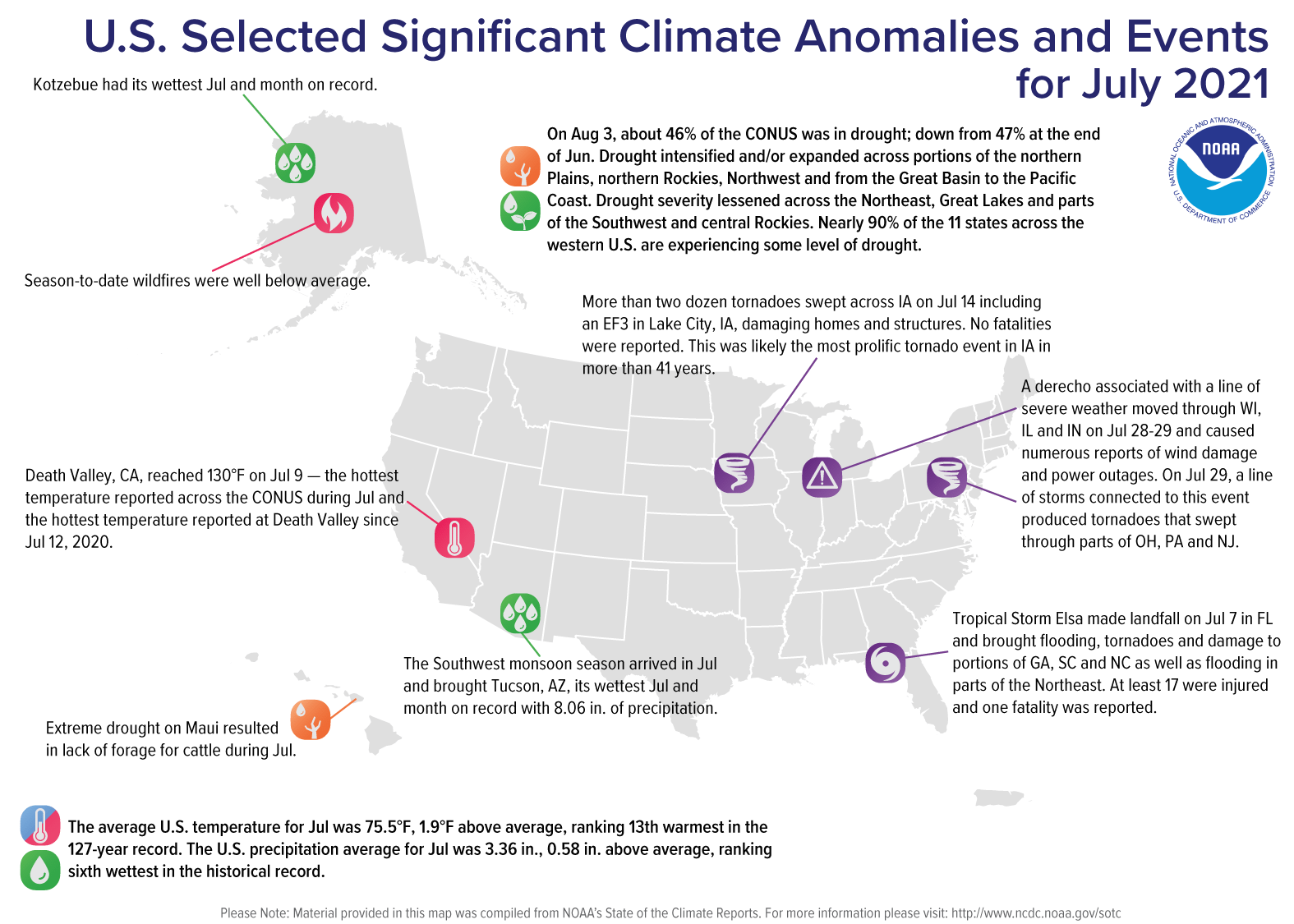
The July 2021 contiguous U.S. temperature was 75.5°F, 1.9°F above the 20th-century average, tying with 1954 and 2003 for 13th warmest in the 127-year record. For the year-to-date, the national temperature was 53.0°F, 1.8°F above average, ranking 14th warmest on record.
The July precipitation total for the contiguous U.S. was 3.36 inches, 0.58 inches above average, and sixth-wettest in the 127-year period of record. The year-to-date precipitation total for the Lower 48 was 18.00 inches, 0.09 inches below average, ranking in the middle one-third of the historical record.
This monthly summary from NOAA National Center for Environmental Information is part of the suite of climate services NOAA provides to government, business, academia, and the public to support informed decision-making.
July 2021
Temperature
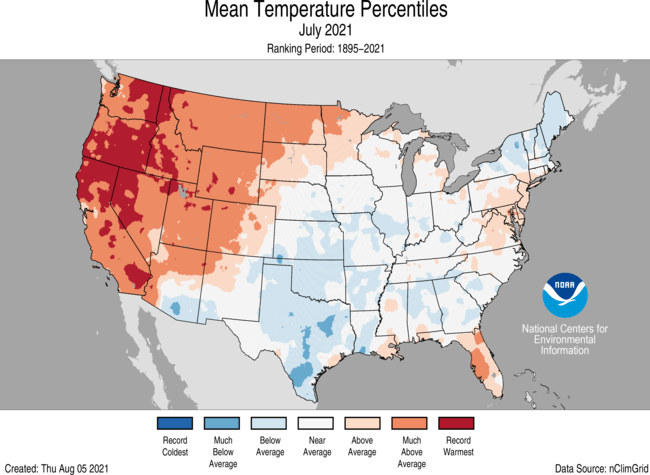
- Temperatures were above average to record warm across the West, much of the northern Plains, and portions of the mid-Atlantic and Southeast. Washington, Oregon, California, and Nevada each had their warmest July on record with five additional states across the West and northern Plains having a top-10 warm month.
- Temperatures were below average across portions of the southern and central Plains, Midwest, Southeast, and Northeast.
- A ridge of high pressure across the western U.S and a trough across the eastern U.S. for most of July kept the temperatures well-above-average across the West and more moderate across the central and eastern states. This pattern remained in place for the duration of the month. An eastward shift in the ridge mid-month allowed the southwestern monsoon to kick off.
- The Alaska average July temperature was 53.7°F, 1.0°F above the long-term mean, and ranked in the warmest third of the historical record for the state.
- Areas that experienced above-average precipitation across western Alaska during July also had temperatures that were below average.
- Above-average temperatures occurred across much of the eastern half of Alaska and across the Aleutians.
- The Alaskan wildfire season, to date, is well below average.
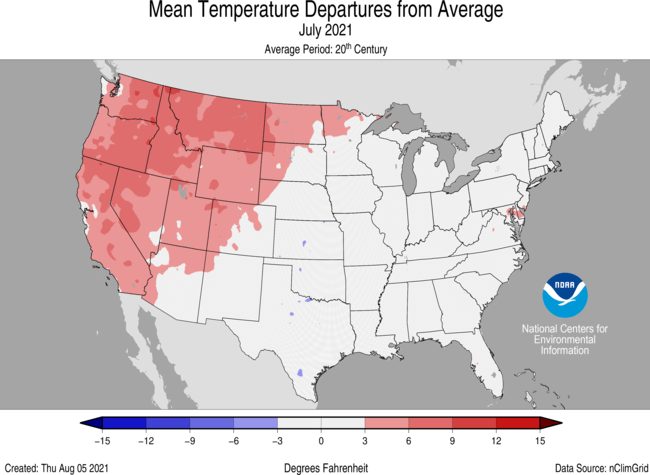
Precipitation
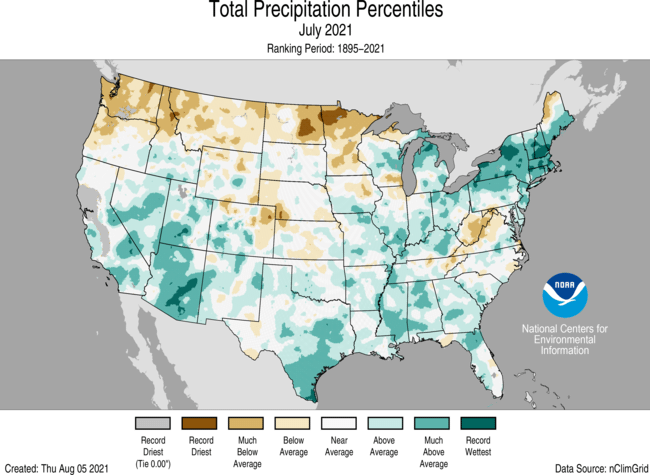
- Precipitation was above average across much of the Northeast, Southeast, and South; portions of the Midwest, Ohio Valley, and Great Lakes; and much of the Southwest. New York and Massachusetts had their wettest July on record with nine additional states across the Northeast, South, and Southwest experiencing a top-10 wettest July.
- The Southwest monsoon season began in earnest during the second half of July, bringing some rainfall to the drought-stricken region. Portions of Colorado, Nevada, New Mexico, Utah, and Arizona saw some improvement in the drought intensity but still remain entrenched in drought.
- Much of the West, particularly the Northwest, remained entrenched in exceptional drought conditions, which was reflected in very high wildfire activity throughout the month.
- Precipitation was below average across much of the Northwest, Northern Tier, and portions of the central Plains, Midwest, and the central Appalachians. Minnesota ranked second driest while Washington ranked fourth driest.
- Hurricane Elsa formed in the Atlantic Ocean in early July and made landfall in Cuba before reemerging in the Gulf of Mexico and making landfall as a tropical storm in Florida.
- Elsa brought flooding, tornadoes, and damage to portions of Georgia and the Carolinas as well as flooding in parts of the Northeast. At least 17 were injured and one fatality was reported.
- Elsa was the earliest fifth-named storm on record.
- Alaska received near-average precipitation during July, but regional amounts varied greatly. Precipitation was above average across much of western Alaska and below-average across eastern Alaska.
- Kotzebue had its wettest July and month on record while Nome and Bethel each had their wettest July since the 1920s.
- According to the August 3 U.S. Drought Monitor, approximately 46 percent of the contiguous U.S. was in drought, down from about 47 percent at the end of June. Drought intensified and/or expanded across portions of the northern Plains, northern Rockies, Northwest and from the Great Basin to the Pacific Coast. Drought also emerged across portions of Alaska and intensified across Maui in Hawaii. Drought severity lessened across the Northeast, Great Lakes, and portions of the Southwest and the central Rockies. Nearly 90 percent of the 11 states across the western U.S. are experiencing some level of drought.
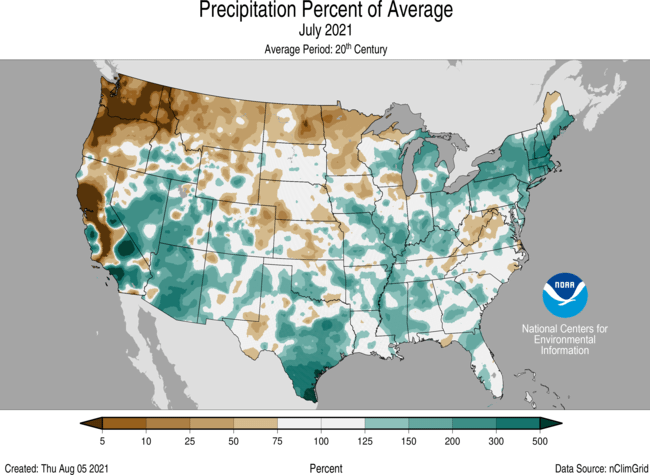
Year-to-date (January–July 2021)
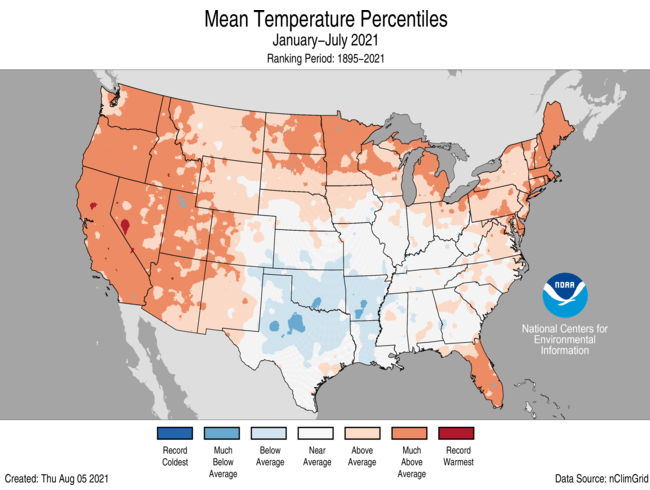
Temperature
- January-July temperatures were above average across the West, northern and central Plains, Great Lakes, Northeast, mid-Atlantic, and portions of the Southeast. California, Oregon, and Nevada each had their fourth-warmest year-to-date period on record with 11 additional states across the West, northern Plains, Northeast, and Southeast experiencing a top-10 warmest January-July.
- Temperatures were below average across portions of the South.
- The Alaska statewide average temperature for this year-to-date period was 27.1°F, 1.3°F above average, and ranked in the middle one-third of the record. Temperatures were above average across much of Bristol Bay, Northwest Gulf, and the Aleutian regions with near-average temperatures present across much of the rest of the state.
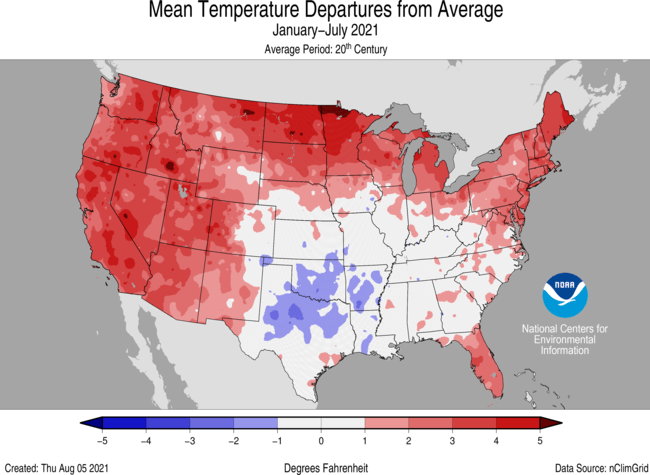
Precipitation
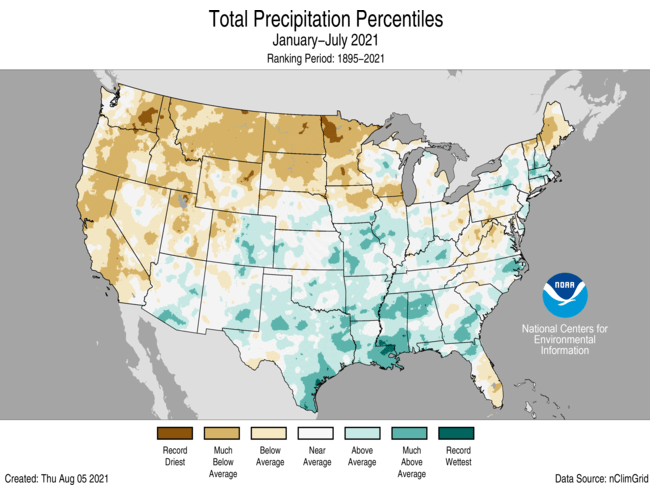
- Precipitation was above average from the southern and central Plains to the Midwest and into portions of the Southeast. Mississippi ranked sixth wettest for the first seven months of the year.
- Precipitation was below average from the West Coast to the western Great Lakes. Minnesota and North Dakota each ranked third driest while Montana ranked fourth driest on record.
- Precipitation across Alaska ranked in the wettest third of the historical record.
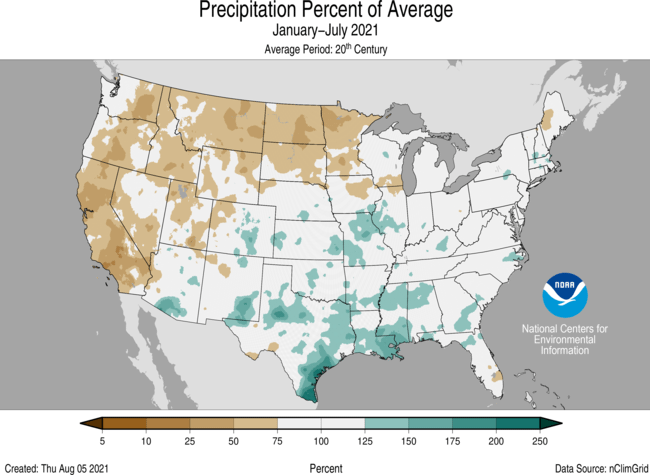
Other Notable Events
- Wildfire activity exploded across the drought-stricken portions of the West, especially the Northwest, during July. As of July 31, 37,650 fires have burned through 2,982,960 acres during the first seven months of 2021. This is nearly 1 million more acres than were consumed by this time last year and about 1 million fewer acres burned than the 2011-2020 year-to-date average.
- With multiple large fires burning across the West, forecasts for worsening conditions, and a potential shortage of resources, on July 14, the National Multi-Agency Coordination Group raised the National Preparedness Level (PL) to the highest category — level 5. This is the earliest PL5 issued in the past 10 years.
- As of July 31, the largest fire across the U.S., the Bootleg Fire, located in Oregon, has consumed more than 413,000 acres and was 56 percent contained.
- The second-largest fire in the U.S., the Dixie Fire, located in northern California, burned more than 240,000 acres and was 24 percent contained.
- Heavy smoke from these and many other fires across the western U.S. and Canada contributed to low air quality across the U.S. during July.
We need better forest management